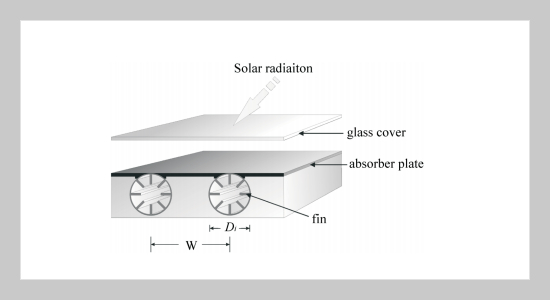REFERENCES
- [1] Klein, S. A., Duffie, J. A. and Beckman, W. A., “Transient Considerations of Flat-Plate Solar Collectors,” J Eng Power Trans ASME, Vol. 96, pp. 109�113 (1974).
- [2] Bojic, M., Kalogirou, S. and Petronijevic, K., “Simulation of a Solar Domestic Water Heating System Using a Time Marching Model,” Renewable Energy, Vol. 27, pp. 441�452 (2002).
- [3] Enibe, S. O. and Iloeje, O. C., “Design Optimization of the Flat Plate Collector for a Solid Absorption Solar Refrigerator” Solar Energy, Vol. 60, pp. 77�87 (1997).
- [4] Haraksingh, I., Mc Doom, I. A. and Hadley, O. St. C., “Natural Convection Flat-Plate Collector Solar Cooker with Short Term Storage,” Renewable Energy, Vol. 9, pp. 729�732 (1996).
- [5] Hermann, M., Koschikowski, J. and Rommel, M., “Corrosion-Free Solar Collectors for Thermally Driven Seawater Desalination,” Solar Energy, Vol. 72, pp. 415�426 (2002).
- [6] Chemkhi, S., Zagrouba F. and Bellagi, A., “Drying of Agricultural Crops by Solar Energy,” Desalination, Vol. 168, pp. 101�109 (2004).
- [7] Hegazy, A. A., “Comparative Study of the Performances of Four Photovoltaic/Thermal Solar Air Collectors,” Energy Conversion & Management, Vol. 41, pp. 861�881 (2000).
- [8] Chiou, J. P., “Experimental Investigation of the Augmentation of Forced Convection Heat Transfer in a Circular Tube Using Spiral Spring Inserts,” Journal of Heat Transfer, Vol. 109, pp. 300�307 (1987).
- [9] Zimparov, V., “Prediction of Friction Factors and Heat Transfer Coefficients for Turbulent Flow in Corrugated Tubes Combined with Twisted Tape Inserts. Part 2: Heat Transfer Coefficients,” International Journal of Heat and Mass Transfer, Vol. 47, pp. 385�393 (2004).
- [10] Chang, S. W. and Su, L. M., “Heat Transfer of Reciprocating Helical Tube Fitted with Full Circumferential Ribs,” International Journal of Heat and Mass Transfer, Vol. 44, pp. 3025�3042 (2001).
- [11] Huq, M., Huq, A. M. A.-U. and Rahman, M. M. “Experimental Measurements of Heat Transfer in an Internally Finned Tube,” International Communications in Heat and Mass Transfer, Vol. 25, pp. 619�630 (1998).
- [12] Yeh, H. M., Ho, C. D. and Lin, C. Y., “Effect of Collector Aspect Ratio on the Collector Efficiency of Upward Type Baffled Solar Air Heaters,” Energy Conversion & Management, Vol. 41, pp. 971�981 (2000).
- [13] Yeh, H. M., Ho, C. D. and Hou, J. Z., “Collector Efficiency of Double-Flow Solar Air Heaters with Fins Attached,” Energy, Vol. 27, pp. 715�727 (2002).
- [14] Ho, C. D., Yeh, H. M. and Wang, R. C., “Heat-Transfer Enhancement in Double-Pass Flat-Plate Solar Air Heaters with Recycle,” Energy, Vol. 30, pp. 2796� 2817 (2005).
- [15] Yeh, H. M., Ho, C. D. and Yeh, C. W., “Effect of Aspect Ratio on the Collector Efficiency of Sheet-andTube Solar Water Heaters with the Consideration of Hydraulic Dissipated Energy,” Renewable Energy, Vol. 28, pp. 1575�1586 (2003).
- [16] Ho, C. D. and Chen, T. C., “The Recycle Effect on the Collector Efficiency Improvement of Double-Pass Sheet-and-Tube Solar Water Heaters with External Recycle,” Renewable Energy, Vol. 31, pp. 953�970 (2006).
- [17] Duffie, J. A. and Beckman, W. A., Solar engineering of thermal processes, Wiley, New York, U.S.A. (1980).
- [18] Klein, S. A., “Calculation of Monthly Average Transmittance-Absorptance Product,” Solar Energy, Vol. 23, pp. 547�551 (1979).
- [19] Watmuff, J. H., Charters, W. W. S. and Proctor, D., “Solar and Wind Induced External Coefficients for Solar Collectors,” Comples, Vol. 2, p. 56 (1977).
- [20] Gnielinski, V., “New Equations for Heat and Mass Transfer in Turbulent Pipe and Channel Flow,” Int. Chemical Engineering, Vol. 16, pp. 359�368 (1976).
- [21] Petukhov, B. S., Advances in heat transfer, Academic Press, New York, U.S.A. (1970).
- [22] Welty, J. R., Wick, C. E. and Wilson, R. E., Fundamentals of momentum, heat, and mass transfer, 3rd ed., Wiley, New York, U.S.A. (1984).
















